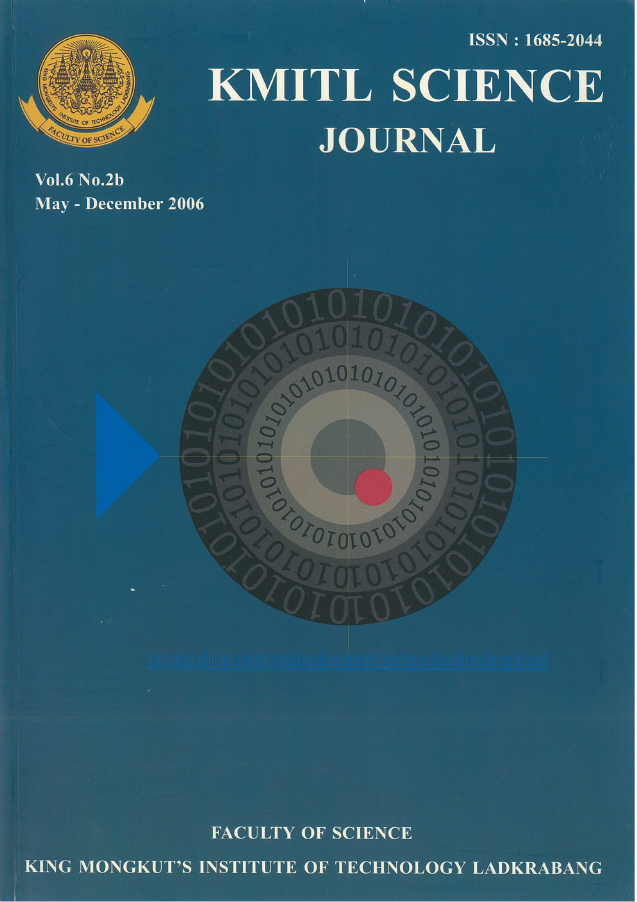Effect of Essential Oil of Carum carvi on Growth Inhibition of Pathogenic Bacteria
Main Article Content
Abstract
The antimicrobial activities of the essential oils of Iranian caraway “Carum carvi” were investigated against Escherichia coli ATCC 25922, Klebsiella pneumonia ATCC 13883, Proteus vulgaris ATCC 13315, and Pseudomonas aeruginosa ATCC 27853. The antimicrobial activities of the essential oils were evaluated by disc diffusion method. The results showed that the essential oil of Carum carvi inhibited the growth of E. coli and K. pneumonia. Furthermore, the study suggests that these essential oils can be used as preservatives in foods.
Keywords: Carum carvi, Antibacterial activity, Escherichia coli, Proteus vulgaris, Klebsiella pneumonia, Pseudomonas aeruginosa, Essential oils
Corresponding author: E-mail: aroiee_h@yahoo.com , aroiee@ferdowsi.um.ac.ir
Article Details
Copyright Transfer Statement
The copyright of this article is transferred to Current Applied Science and Technology journal with effect if and when the article is accepted for publication. The copyright transfer covers the exclusive right to reproduce and distribute the article, including reprints, translations, photographic reproductions, electronic form (offline, online) or any other reproductions of similar nature.
The author warrants that this contribution is original and that he/she has full power to make this grant. The author signs for and accepts responsibility for releasing this material on behalf of any and all co-authors.
Here is the link for download: Copyright transfer form.pdf
References
[2] Beuchat, L.R., and Golden, D.A. 1989 Antimicrobial Occurring Naturally in Food, Food Technology, 43, 134-142.
[3] Bowles, B.L., and Juneja, V.K. 1998 Inhibition of Food-Borne Bacterial Pathogens by Naturally Occurring Food Additives, Journal of Food Safety, 18 : 101-112.
[4] Camporese, A., Balick, M.J., Arvigo, R., Esposito, R.G., Morsellino, N., De Simone, F., and Tubaro, A. 2003 Screening of Anti-Bacterial Activity of Medicinal Plants from Belize (Central America), Journal of Ethnopharmacology, 87: 103-107.
[5] Chaibi, A., Ababouch, L.H., Bllasri, K., Boucetta, S., and Busta, F.F. 1997 Inhibition of Germination and Vegetative Gowth of Bacillus cereus T and Clostridium botulinum 62A Spores by Essential Oils, Food Microbiology, 14, 161-174.
[6] Chang, H.W. 1995 Antimicrobial Effect of Spices and Vegetables, Food Industries (ROC), 27, 53-61.
[7] Cosentino, S., Tuberoso, C.I.G., Pisano, B., Satta, M., Mascia, V., Arzedi, E., and Palmas, F. 1999 In Vitro Antimicrobial Activity and Chemical Composition of Sardinian Thymus Essential Oils, Lett. Appl. Microbiol,. 29, 130-135.
[8] Cowan, M.M. 1999 Plant Products as Anti Microbial Agents, Clinical Microbiology Reviews, 12, 564-582.
[9] Davidson, P.M. 1997 Chemical Preservatives and Natural Antimicrobial Compounds : In : Doyle, M.P., Beuchat, L.R., Montville, T.J. (Eds.), Food Microbiology. Fundamental and Frontiers. ASM Publications, Washington, DC, pp.520-556.
[10] Elgayyar, M., Draughon, F.A., Golden, D.A., and Mount, J.R. 2001 Antimicrobial Activity of Essential Oils from Plants Against Selected Pathogenic and Saprophytic Microorganisms, J. Food Prot., 64, 1019-1024.
[11] Essawi, T., and Srour, M. 2000 Screening of Some Palestinian Medicinal Plants for Antibacterial Activity, Journal of Ethnopharmacology, 70 : 343-349.
[12] Juven, B.J., Kanner, J., Schved, F., and Weisslowicz, H. 1994 Factors That Interact with the Antibacterial Action of Thyme Essential Oil and Its Active Constituents, Journal of Applied Bacteriology, 76, 626-631.
[13] Lachowicz, K.J., Jones, G.P., Briggs, D.R., Bienvenu, F.E., Wan, J., Wilcock, A., and Coventry, M.J. 1998 The Synergistic Preservative Effects of the Essential Oils of Sweet Basil (Ocimum basilicum L.) Against Acid Tolerant Food Microflora, Letters in Applied Microbiology, 26, 209-214.
[14] Li, R., Teng, D., Du, G., and Wang, B. 2000 Isolation of Rosmarinic Acid from Callus of Perilla frutescens and Studies of Its Inhibition on the Growth of Bacteria and Fungus, Weishengwuxue Tongbao, 27, 324-327.
[15] O’ Gara, E., Hill, D.J., and Maslin, D.J. 2000 Activities of Garlic Powder, and Their Diallyl Constituents Against Helicobacter Pylori, Appl. Environ. Microbiol., 66, 2269-2273.
[16] Olukoya, D.K., Idika, N., and Odugbemi, T. 1993 Antimicrobial Activity of Some Medicinal Plants from Nigeria. Journal of Ethnopharmacology ,39, 69-72.
[17] Smith-Palmer, A., Stewart, J., and Fyfe, L. 1998 Antimicrobial Properties of Plants Essential Oils and Essences Against Important Foodborne Pathogens, Lett. Appl. Microbiol., 26, 118-122.
[18] Rojas, A., Hernandez, L., Pereda-Miranda, R., and Mata, R. 1992 Screening for Antimicrobial Activity of Crude Drug Extracts and Pure Natural Products from Mexican Medical Plants, Journal of Ethnopharmacology, 35, 275-283.
[19] Sagdic, O., Kuscu, A., Ozcan, M., and Ozcelik, S. 2002 Effects of Turkish Spice Extracts at Various Concentrations on the Growth of Escherichia coli 0157:H7, Food Microbiology, 19: 473-480.
[20] Shelef, L.A. 1983 Antimicrobial Effects of Spices, Journal of Food Safety, 6, 29-44.
[21] Sivropoulo, A., Papanikolaou, E., Nikolaou, C., Kokkini, S., Lanaras, T., and Arsenakis, M.1996 Antimicrobial and Cytotoxic Activities of Origanum Essential Oils, Journal of Agricultural and Food Chemistry, 44, 1202-1205.
[22] Sokmen, A., Jones, B. M., and Erturk, M. 1999 The In Vitro Antibacterial Activity of Turkish Medicinal Plants, Journal of Ethnopharmacology, 67 : 79-86.
[23] Tassou, C.C., Drosinos, E.H., and Nychas, G.J.E. 1995 Effects of Essential Oil From Mint(Mentha piperita) on Salmonella enteritidis and Listeria monocytogenes in Model Food Systems at 4°C and 10°C, Journal of Applied Bacteriology, 78, 593-600.
[24] Ting, E.W.T., and Deibel, K.E. 1992 Sensitivity of Listeria monocytogenes to Spices at Two Temperatures, Journal of Food Safety, 12, 129-137.
[25] Valero, M., and Salmeron, M.C. 2003 Antibacterial Activity of 11 Essential Oils Against Bacillus Ocereus in Tynadallized Carrot Broth, International Journal of Food Microbiology, 85 : 73-81.
[26] Wan, J., Wilcock, A., and Coventry, M.J. 1998 The Effect of Essential Oils of Basil on the Growth of Aeromonas hydrophila and Pseudomonas flurescens, Journal of Applied Microbiology, 84, 152-158.
[27] Zaika, L.L. 1988 Spices and Herbs: Their Antimicrobial Activity and Its Determination, Journal of Food Safety, 9, 97-118.
[28] http://www.Botanica.com, A modern Herbal, Grieve, M. 2006 Caraway, Botanica.com


